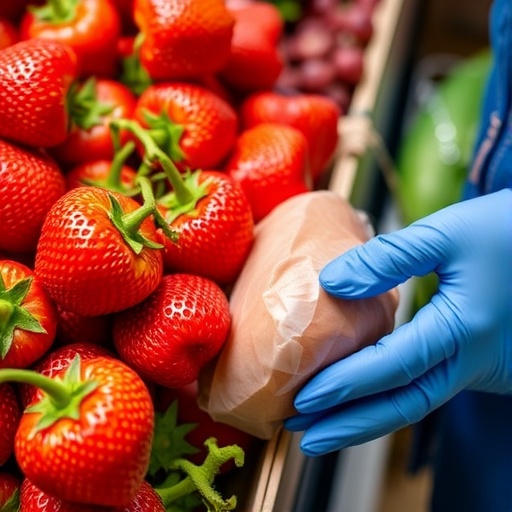In a world increasingly challenged by food security issues, innovative approaches to postharvest management are essential for maintaining the quality and nutritional value of fruits and vegetables. Recent research highlights the potential of edible coatings as an effective strategy to enhance the longevity and freshness of perishable produce. A comprehensive review conducted by Alemu, Intipunya, and Gebeyo offers valuable insights into this area, examining various types of edible coatings and their efficacy in preserving the quality of agricultural products.
The study emphasizes that edible coatings can serve as a barrier to moisture loss and external contaminants while also allowing for gas exchange. The role of these coatings in extending the shelf life of fresh produce cannot be understated, especially in regions with limited access to refrigeration. As the global population continues to grow, the need for sustainable and efficient methods of food preservation becomes even more pressing. Edible coatings may hold the key to addressing these challenges by reducing food wastage and promoting nutrient retention.
Among the various types of edible coatings discussed in the review, natural polymers such as alginate, chitosan, and pectin are highlighted for their biodegradable properties and compatibility with food items. These materials not only provide a physical barrier but also possess antimicrobial properties that can inhibit spoilage. The incorporation of essential oils into these coatings has been shown to enhance their functional properties, offering not only preservation benefits but also potential health advantages thanks to the antimicrobial effects of these natural compounds.
Furthermore, the research underscores the significance of the coating application method, which can greatly impact the effectiveness of the edible films. Techniques such as dipping, spraying, or even the use of electrospinning can influence the coating’s uniformity and adherence to the fruit or vegetable surface. This precision in application is crucial for maximizing the benefits of edible coatings in real-world scenarios, providing a greater potential for commercial adoption in the agricultural sector.
The review also explores the various interactions that occur between coatings and produce. Factors such as fruit maturity, surface characteristics, and storage conditions can influence the performance of edible coatings. Understanding these interactions is essential for optimizing coating formulations and application methods tailored to specific types of produce, ensuring that each option chosen provides the best results for the intended application.
Consumer acceptance of edible coatings is another critical consideration. As awareness of food preservation techniques grows, it is vital to educate consumers about the safety and benefits associated with edible coatings. Transparency in labeling and clear communication of the advantages these coatings provide—such as reduced food spoilage and improved nutritional value—will be essential in promoting their widespread use.
Additionally, the environmental implications of edible coatings merit attention. As biodegradable options gain traction, the potential to reduce plastic waste associated with traditional packaging is a considerable advantage. Edible coatings present a sustainable alternative that aligns with the increasing demand for eco-friendly practices in the food industry, resonating well with environmentally conscious consumers.
As the authors delve deeper into specific applications, they reveal that different fruits and vegetables respond uniquely to various types of coatings. Research indicates that while some coatings may be highly effective for certain produce, they may not yield the same results for others. This specificity underscores the importance of tailored solutions in edible coating formulations—a nuanced approach that could revolutionize how we manage postharvest processes.
In conclusion, the comprehensive nature of this research reflects the promising role of edible coatings in food preservation. By enhancing the quality and safety of fruits and vegetables postharvest, these coatings may significantly contribute to food security and nutrition globally. With continued innovation and investigation, the field of edible coatings is poised for substantial growth, potentially transforming the landscape of agricultural management and consumer practices in the years to come.
As we look towards the future, intelligent policies encouraging the adoption of these technologies will play a crucial role in realizing their full potential. Governments and institutions should invest in research and infrastructure that supports the development and implementation of edible coatings, paving the way for advancements in agricultural sustainability. This strategic approach not only addresses food security but can also catalyze economic growth within the agricultural sector, creating new opportunities for farmers, researchers, and businesses alike.
The importance of interdisciplinary collaboration cannot be overemphasized in this context. By bringing together expertise from agricultural sciences, food technology, and consumer education, stakeholders can ensure that advancements in edible coating technologies are grounded in both practicality and innovation. This holistic approach may well be the driving force behind effective solutions that cater to the increasingly complex challenges posed by global food systems, ultimately benefiting both producers and consumers.
Overall, the review by Alemu, Intipunya, and Gebeyo serves as a clarion call for the agricultural community. As we embrace technology and innovative practices, the future of edible coatings promises not only enhanced food preservation but also broader implications for health, economy, and environmental sustainability. By paying heed to the insights shared in this substantial study, stakeholders at all levels can contribute to a more secure and sustainable food future.
Subject of Research: Edible coatings for postharvest management of fruits and vegetables
Article Title: A comprehensive review of edible coatings for postharvest management of fruits and vegetables: enhancing food and nutrition security.
Article References:
Alemu, T.T., Intipunya, P. & Gebeyo, B.A. A comprehensive review of edible coatings for postharvest management of fruits and vegetables: enhancing food and nutrition security.
Discov Agric 3, 190 (2025). https://doi.org/10.1007/s44279-025-00348-8
Image Credits: AI Generated
DOI: 10.1007/s44279-025-00348-8
Keywords: Edible coatings, postharvest management, food preservation, food security, sustainable agriculture.




